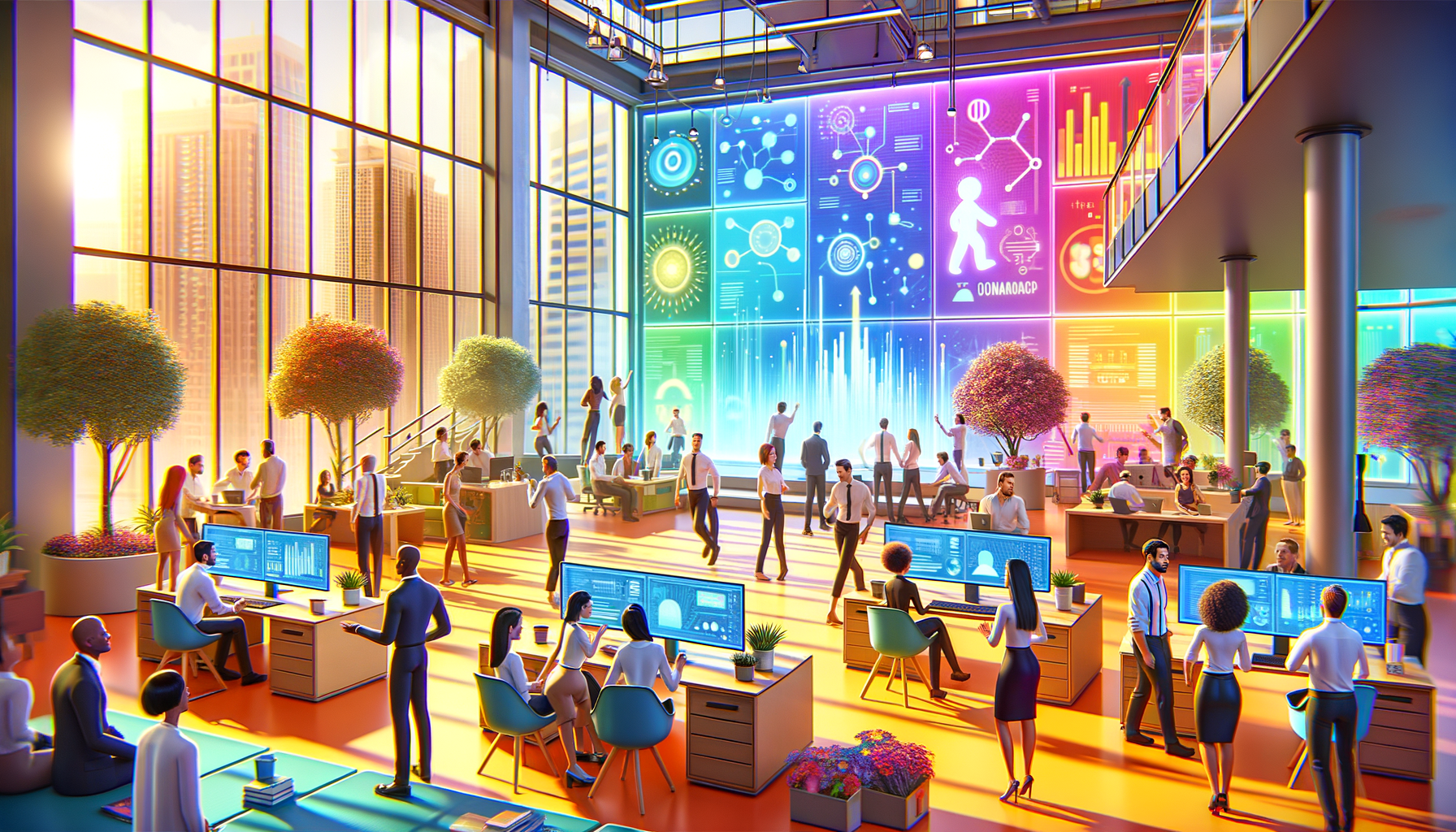How Generative AI is Transforming the Business World
In recent years, the business landscape has experienced a remarkable transformation, primarily driven by the rapid advancement and integration of generative artificial intelligence (AI). This powerful technology is reshaping industries, revolutionizing processes, and unlocking new avenues for innovation and growth. As we delve into the impact of generative AI on the business world, we will uncover how it is changing the way companies operate, interact with customers, and drive value in an increasingly digital age.
The Rise of Generative AI in Business
Generative AI, a subset of artificial intelligence that can create new content, ideas, and solutions, has rapidly emerged as a game-changer for businesses across various sectors. Its ability to analyze vast amounts of data, learn from patterns, and generate human-like outputs has captivated the attention of industry leaders and entrepreneurs alike.
Adoption Rates Soar
The adoption of generative AI in business has been nothing short of extraordinary. According to a recent McKinsey survey, nearly 65% of organizations are now regularly using generative AI in their business operations. This figure represents a dramatic increase from the previous year, nearly doubling the percentage of businesses embracing this technology. This surge reflects a growing recognition of AI’s potential to enhance productivity and drive competitive advantage.
Key Benefits Driving Adoption
Several factors are contributing to the rapid uptake of generative AI:
- Enhanced Efficiency: By automating repetitive tasks, generative AI frees up human resources for more complex and creative endeavors. This shift allows employees to focus on higher-value activities, fostering a more innovative workplace.
- Improved Decision-Making: AI-driven insights help businesses make more informed, data-backed decisions. With access to real-time analytics, organizations can respond swiftly to market changes and customer needs.
- Personalization at Scale: Generative AI enables the creation of tailored experiences for individual customers or users. This level of customization not only enhances customer satisfaction but also drives loyalty and retention.
- Innovation Acceleration: The technology’s ability to generate new ideas and solutions fosters innovation across various business functions. Companies can experiment with new concepts without the traditional constraints of time and resources.
Transforming Industries Through Generative AI
The impact of generative AI is being felt across a wide range of industries, each finding unique ways to leverage its capabilities.
Finance
In the financial sector, generative AI is making significant strides by:
- Enhancing Risk Assessment Models: AI algorithms analyze historical data to predict potential risks, allowing financial institutions to make proactive decisions.
- Automating Fraud Detection Processes: By identifying unusual patterns in transactions, generative AI helps prevent fraudulent activities, safeguarding both businesses and consumers.
- Providing Personalized Financial Advice: AI-driven tools analyze individual financial situations, offering tailored recommendations that meet specific customer needs.
- Generating Detailed Financial Reports and Analysis: Automation of report generation not only saves time but also ensures accuracy and consistency in financial reporting.
Healthcare
The healthcare industry is reaping the benefits of generative AI through:
- Improved Diagnostic Accuracy: AI systems analyze medical data to assist healthcare professionals in diagnosing conditions more accurately and swiftly.
- Personalized Treatment Plans: By considering individual patient data, generative AI helps create customized treatment plans, enhancing patient outcomes.
- Drug Discovery and Development: AI accelerates the drug discovery process by predicting how different compounds will interact, significantly reducing the time and cost involved.
- Enhanced Patient Monitoring Systems: AI tools monitor patient vitals in real-time, alerting healthcare providers to any significant changes that require immediate attention.
Manufacturing
Generative AI is revolutionizing manufacturing by:
- Optimizing Production Processes: AI algorithms analyze production data to identify inefficiencies, leading to streamlined operations and reduced costs.
- Predicting Equipment Maintenance Needs: By analyzing equipment performance data, generative AI can forecast maintenance requirements, minimizing downtime and extending machinery lifespan.
- Designing New Products and Prototypes: AI-driven design tools assist engineers in creating innovative products, enabling rapid prototyping and iteration.
- Enhancing Quality Control Measures: Generative AI systems monitor production quality in real-time, ensuring that products meet established standards before reaching consumers.
Marketing and Advertising
In the realm of marketing, generative AI is:
- Creating Personalized Content for Targeted Campaigns: AI analyzes consumer behavior to generate content that resonates with specific audience segments, increasing engagement.
- Generating Ad Copy and Visual Designs: AI tools can produce compelling advertisements quickly, allowing marketers to focus on strategy rather than execution.
- Analyzing Consumer Behavior for Better Targeting: By examining large datasets, generative AI provides insights into consumer preferences, enabling more effective marketing strategies.
- Optimizing Marketing Strategies in Real-Time: AI algorithms continuously analyze campaign performance, allowing marketers to adjust tactics on the fly for maximum impact.
The Power of Personalization
One of the most significant ways generative AI is changing the business world is through its ability to deliver highly personalized experiences and solutions.
Tailored Customer Experiences
Generative AI enables businesses to create unique, context-aware interactions with their customers. This level of personalization can:
- Increase Customer Satisfaction and Loyalty: When customers feel understood and valued, they are more likely to remain loyal to a brand.
- Boost Engagement Rates: Personalized experiences lead to higher engagement, as customers are more likely to interact with content that speaks to their interests.
- Drive Higher Conversion Rates: Tailored offers and recommendations can significantly improve conversion rates, turning potential customers into loyal buyers.
- Enhance Overall Customer Lifetime Value: By fostering strong relationships through personalization, businesses can increase the lifetime value of their customers.
Adaptive Products and Services
Companies are using generative AI to develop products and services that adapt to individual user needs and preferences. This approach:
- Improves Product Functionality and User Experience: AI-driven insights lead to continuous product enhancements that align with user expectations.
- Increases Product Adoption and Retention Rates: When products meet user needs effectively, customers are more likely to adopt and continue using them.
- Enables Continuous Improvement Based on User Feedback and Behavior: Generative AI allows companies to gather and analyze user feedback, driving ongoing product development.
Content Creation and Creative Industries
The creative sector is undergoing a paradigm shift with the introduction of generative AI tools capable of producing high-quality content across various mediums.
Writing and Journalism
Generative AI is being utilized to:
- Draft Articles and Reports: AI can generate initial drafts, allowing writers to focus on refining content rather than starting from scratch.
- Generate Story Ideas and Outlines: AI tools can suggest topics and structures, sparking creativity and reducing writer’s block.
- Assist with Research and Fact-Checking: AI can quickly gather and verify information, ensuring that content is accurate and well-informed.
- Create Personalized News Feeds: AI algorithms analyze user preferences to curate news content that aligns with individual interests.
Visual Arts and Design
In the visual arts, generative AI is:
- Producing Unique Artwork and Designs: AI can create original pieces of art, offering artists new tools for expression and creativity.
- Assisting with Photo and Video Editing: AI-driven editing software streamlines the editing process, enabling creators to produce high-quality content more efficiently.
- Generating 3D Models and Animations: AI tools can quickly generate complex 3D models, enhancing the capabilities of designers and animators.
- Creating Realistic Visual Effects for Film and Gaming: AI enhances visual storytelling by producing lifelike effects that elevate the overall viewing experience.
Music and Audio Production
The music industry is leveraging generative AI for:
- Composing Original Melodies and Harmonies: AI can generate unique musical compositions, providing inspiration for artists and producers.
- Generating Lyrics: AI tools can assist songwriters by suggesting lyrics based on themes and styles.
- Creating Personalized Playlists: AI analyzes listening habits to curate playlists that match individual tastes, enhancing the user experience.
- Enhancing Audio Quality and Production: AI-driven tools can improve sound quality, making the production process more efficient and effective.
Data-Driven Insights and Decision Making
Generative AI is revolutionizing how businesses gather, analyze, and act upon data.
Retrieval-Augmented Generation (RAG)
This hybrid approach combines the power of generative AI with extensive external datasets, resulting in:
- More Accurate and Contextually Relevant Outputs: By integrating diverse data sources, generative AI can produce outputs that are not only relevant but also insightful.
- Enhanced Quality of AI-Generated Content: RAG improves the overall quality of content produced by AI, making it more reliable for business applications.
- Improved Decision-Making Processes: Organizations can leverage RAG to make more informed decisions based on comprehensive data analysis.
Predictive Analytics
Generative AI is enhancing predictive analytics by:
- Identifying Complex Patterns in Large Datasets: AI algorithms can uncover intricate relationships within data that may not be apparent to human analysts.
- Generating More Accurate Forecasts and Projections: AI-driven predictions are based on real-time data, leading to better business planning and strategy.
- Simulating Various Scenarios for Better Strategic Planning: Generative AI allows businesses to model different scenarios, helping them prepare for potential challenges and opportunities.
Challenges and Considerations
While the benefits of generative AI in business are substantial, organizations must also address several challenges:
Ethical Concerns
- Ensuring Responsible Use of AI-Generated Content: Businesses must establish guidelines for the ethical use of AI-generated materials to prevent misuse.
- Addressing Potential Biases in AI Models: AI systems can inadvertently perpetuate biases present in training data, necessitating ongoing monitoring and adjustment.
- Maintaining Transparency in AI-Driven Decision-Making: Organizations should strive for transparency in how AI influences decisions, fostering trust among stakeholders.
Data Privacy and Security
- Protecting Sensitive Information Used to Train AI Models: Businesses must implement robust security measures to safeguard data used in AI training.
- Ensuring Compliance with Data Protection Regulations: Organizations must navigate complex legal landscapes to ensure compliance with data privacy laws.
- Safeguarding Against Potential AI-Related Security Vulnerabilities: As AI systems become more integrated into business operations, the risk of cyber threats increases, necessitating proactive security measures.
Workforce Impact
- Managing the Transition of Roles Affected by AI Automation: Organizations must prepare for changes in job roles as AI takes over repetitive tasks, ensuring a smooth transition for employees.
- Upskilling Employees to Work Alongside AI Systems: Investing in employee training is crucial to equip the workforce with the skills needed to collaborate effectively with AI.
- Addressing Concerns About Job Displacement: Open communication about the role of AI in the workplace can alleviate fears and foster a culture of adaptability.
The Future of Generative AI in Business
As generative AI continues to advance, its integration with other cutting-edge technologies promises even greater potential for business innovation.
AI and Quantum Computing
The combination of generative AI and quantum computing could lead to:
- Unprecedented Processing Power for Complex AI Models: Quantum computing can enhance the capabilities of AI, allowing for more sophisticated analyses and predictions.
- Solving Previously Intractable Business Problems: The synergy between AI and quantum computing may enable businesses to tackle challenges that were once deemed unsolvable.
- Accelerated Drug Discovery and Materials Science Advancements: The integration of these technologies could revolutionize industries by significantly speeding up research and development processes.
Edge Computing and AI
Integrating generative AI with edge computing may result in:
- Faster, More Efficient AI Processing at the Device Level: Edge computing allows AI to operate closer to the source of data, reducing latency and improving performance.
- Enhanced Privacy and Security for AI Applications: Processing data locally minimizes the risk of data breaches and enhances user privacy.
- Improved Real-Time Decision-Making Capabilities: AI applications can respond more quickly to real-time data, enabling businesses to make timely decisions.
AI-Powered Automation
The future of business automation will likely see:
- More Sophisticated AI-Driven Robotic Process Automation (RPA): AI will enhance RPA capabilities, allowing for more complex and intelligent automation solutions.
- Autonomous Systems Capable of Complex Decision-Making: Businesses may implement AI systems that can operate independently, making decisions based on real-time data.
- AI-Orchestrated Supply Chains and Logistics Networks: AI can optimize supply chain management, improving efficiency and reducing costs across the board.
Preparing for the Generative AI Revolution
To harness the full potential of generative AI, businesses should consider the following steps:
- Invest in AI Education: Ensure your workforce is equipped with the knowledge and skills to work effectively with AI technologies. This investment will pay dividends as employees become more adept at leveraging AI tools.
- Develop an AI Strategy: Create a comprehensive plan for integrating generative AI into your business processes and objectives. A well-defined strategy will guide your organization through the complexities of AI adoption.
- Start with Pilot Projects: Begin with small-scale implementations to test and refine your approach to generative AI. Pilot projects allow organizations to learn and adapt before scaling up.
- Foster a Culture of Innovation: Encourage experimentation and creativity in applying generative AI to solve business challenges. A culture that embraces innovation will position your organization as a leader in AI adoption.
- Prioritize Ethical AI Practices: Establish guidelines and frameworks for responsible AI use within your organization. Ethical considerations should be at the forefront of AI initiatives to build trust and accountability.
- Collaborate and Partner: Seek partnerships with AI experts, startups, and research institutions to stay at the forefront of AI innovation. Collaboration can provide valuable insights and resources to enhance your AI initiatives.
Conclusion
Generative AI is undeniably reshaping the business world, offering unprecedented opportunities for efficiency, innovation, and growth. As this technology continues to evolve, it will play an increasingly central role in how companies operate, compete, and create value. By embracing generative AI and thoughtfully addressing its challenges, businesses can position themselves to thrive in an AI-driven future.
The transformation brought about by generative AI is not just a fleeting trend but a fundamental shift in the business landscape. As we move forward, the companies that successfully integrate this powerful technology into their operations and strategies will likely be the ones that lead their industries and define the future of business.
Sources:
- https://appinventiv.com/blog/ai-trends/
- https://www.marketsandmarkets.com/Market-Reports/artificial-intelligence-market-74851580.html
- https://www.eweek.com/artificial-intelligence/ai-trends/
This article is generated help of SafeComs AI, Automation Bot.
.





Leave a Reply